1. Overview of Lithium-Ion Batteries
A lithium-ion battery is a type of secondary battery (rechargeable battery) that primarily relies on the movement of lithium ions between the positive and negative electrodes to operate. During the charge-discharge process, Li⁺ is intercalated into and deintercalated from the two electrodes alternately: when charging, Li⁺ is deintercalated from the positive electrode, moves through the electrolyte, and is intercalated into the negative electrode, leaving the negative electrode in a lithium-rich state; the reverse occurs during discharge.
The voltage range of a lithium-ion battery is 2.8V to 4.2V, with a typical voltage of 3.7V. The battery will be at risk of damage if the voltage drops below 2.8V or exceeds 4.2V.
2. Concepts of 1C and 0.1C
The unit of battery capacity is mAh, and “C” refers to the charge-discharge rate of the battery. For example, for a 2000mAh battery, discharging at 1C means a discharge current of 2000mA, while discharging at 0.1C means a current of 200mA. The same logic applies to charging.
3. Advantages and Disadvantages of Lithium-Ion Batteries
Main Advantages:
·High voltage and high energy density;
·Long cycle life: generally 500 cycles, and even up to 1000+ cycles;
·Low self-discharge: the self-discharge rate of a fully charged Li-ion battery stored at room temperature for one month is approximately 2%;
·Fast charging capability: up to 80% of the nominal capacity can be achieved when charging at 1C;
·Wide operating temperature range: typically -25°C to 45°C, with potential future expansion to -40°C to 70°C;
·No memory effect (unlike Ni-Cd and Ni-Mh batteries), so there is no need to drain the remaining power before charging;
·More environmentally friendly and pollution-free compared to Ni-Cd and Ni-Mh batteries (free of heavy metals such as cadmium and mercury).
Main Disadvantages:
·High cost;
·Requires a protective circuit board (including overcharge and over-discharge protection);
·Cannot withstand high-current discharge: the discharge current is generally below 0.5C, as excessive current causes internal heat generation in the battery;
·Poor safety: prone to explosion and fire.
4. Differences Between Lithium Batteries and Lithium-Ion Batteries
Lithium batteries and lithium-ion batteries are two distinct concepts, with the main differences as follows:
·The positive electrode material of lithium batteries is manganese dioxide or thionyl chloride, and the negative electrode is lithium metal;
·Lithium-ion batteries are lithium batteries that use lithium-containing compounds as the positive electrode. During the charge-discharge process, there is no metallic lithium, only lithium ions;
·Lithium batteries are also called primary lithium batteries. They can discharge continuously or intermittently, but once their energy is exhausted, they can no longer be used or recharged;
·Lithium-ion batteries are also called secondary lithium batteries and can be recharged and discharged repeatedly.
5. Charging Modes of Lithium-Ion Batteries
The ideal charging mode for lithium-ion batteries is called the CC CV mode (i.e., Constant Current-Constant Voltage mode).
In the diagram below: gray represents battery voltage, green represents charging current, and red represents battery capacity.
When the battery voltage is low, the battery is charged at a fixed constant current. When the battery voltage reaches 4.2V, the mode switches from constant current to constant voltage. Since the battery voltage must not exceed 4.2V, the system gradually reduces the charging current until it is close to 0. When the battery voltage is 4.2V and the charging current is 0, the battery is fully charged.
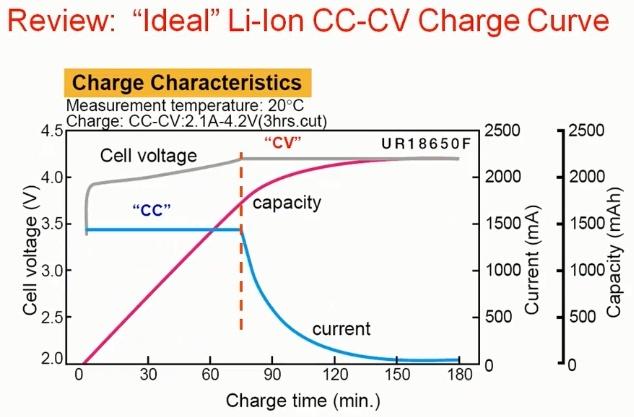
To ensure absolute battery safety, the actual charging process is more refined. Charging an unstable battery with constant current directly can cause greater damage to the battery. The detailed stages are as follows:
·Test mode: When the battery voltage is below 2V, a very small current is used to wake up the battery;
·Trickle charging (pre-charging mode): When the battery voltage is between 2V and 3V, pre-charging is performed at a current of 1/10 or 1/20 of the constant current charging current;
·Constant current charging: When the battery voltage rises above 3V, the battery is rapidly charged in constant current mode;
·Constant voltage charging: When the battery voltage reaches 4.2V, the battery is charged in constant voltage mode.
For example, in TI’s solution, charging stops when the battery voltage is 4.2V and the charging current is low (but not 0)—approximately 1/10 of the constant current charging current. At this point, the battery voltage will drop to 4.16V or 4.17V.
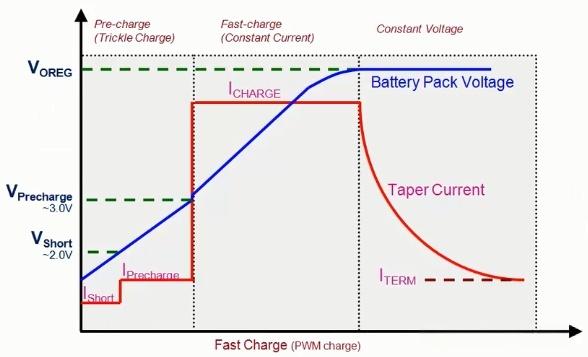
6. Why the Charge Cut-Off Voltage of Lithium-Ion Batteries Is 4.2V
The diagram below shows the relationship between battery cycle life and charge cut-off voltage. In the early cycles of the battery, charging to a slightly higher voltage can yield higher capacity per cycle, but this effect only lasts for a short period. When the charging voltage is 50mV or 100mV higher than the recommended maximum voltage of 4.2V, the battery aging rate accelerates significantly due to slight overcharging in each cycle.
In summary: If the battery’s charge cut-off voltage is higher than 4.2V, the higher the voltage, the shorter the cycle life, and the faster the battery capacity degrades.
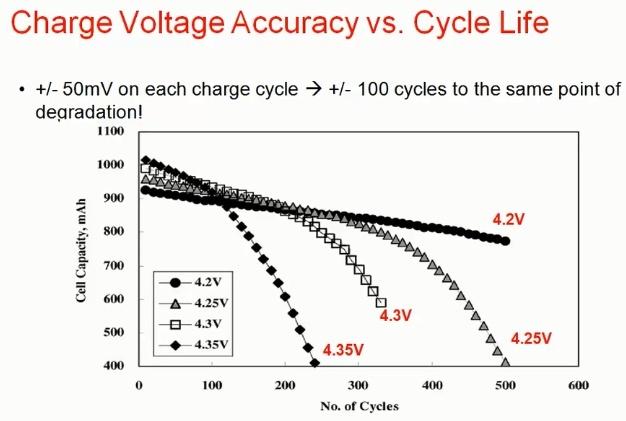
7. Discharge Curves of Lithium-Ion Batteries
The following are the discharge curves of lithium-ion batteries under different discharge currents. It can be observed that: the higher the discharge current, the faster the battery capacity degrades, the lower the capacity, and the less fully the battery’s nominal capacity is utilized.
When the battery capacity is lower, the internal resistance of the battery increases significantly. When discharging at a relatively high current, the internal resistance increases more rapidly.
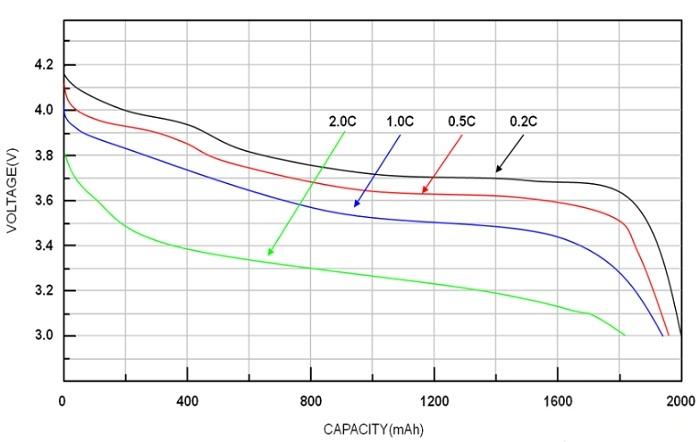
From the battery discharge curves at different temperatures, it can be seen that: the lower the temperature, the faster the battery capacity degrades, and the less fully the battery discharges.
When the battery temperature is below 0°C, the internal active components become less active, and the internal resistance increases accordingly; excessively high temperatures also damage the battery.
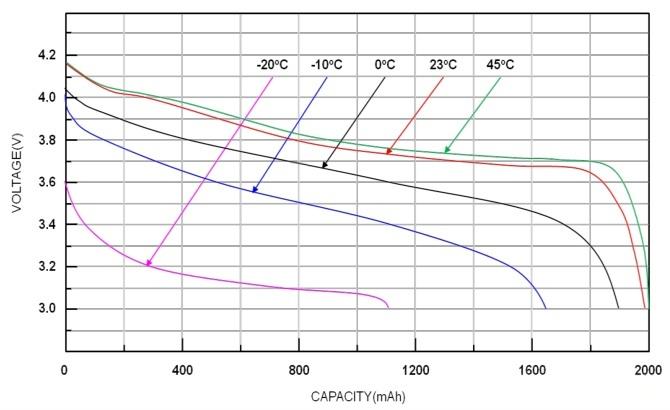
8. Cycle Count of Lithium-Ion Batteries
In practice, one cycle is counted each time the cumulative discharge capacity equals the design capacity.
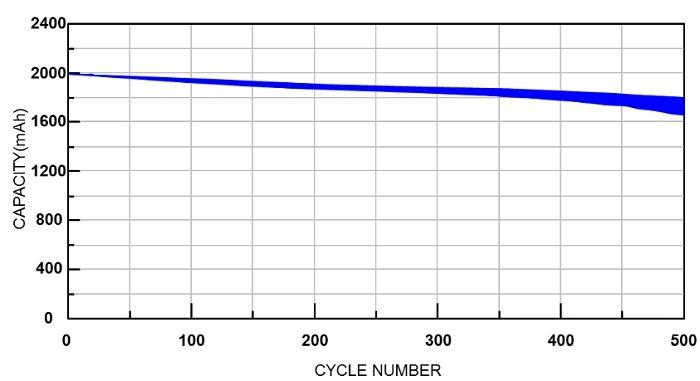
National Standards stipulate the test conditions and requirements for the cycle life of lithium-ion batteries:
At a room temperature of 25°C, charge at 1C for 150 minutes, then discharge at a constant current of 1C until the voltage drops to 2.75V—this constitutes one cycle.The test ends when the discharge time of any cycle is less than 36 minutes, and the total number of cycles must exceed 300.
·The cycle life test is conducted using the deep charge and deep discharge method;
·After following this test mode, the battery must retain more than 60% of its capacity after exceeding 300 cycles.



